Menus
- The 2000 GP250 World Champion
- 90 ° V-twin, 249 cc, 97 hp, 268 km / h, 97 kg
- Discovery
- In the saddle
- Test
- Conclusion
The 2000 GP250 World Champion
90 ° V-twin, 249 cc, 97 hp, 268 km / h, 97 kg
In 2000, Olivier Jacque dazzled Grand Prix enthusiasts riding the Yamaha of the Tech 3 team by winning the 250 GP World Championship, thus becoming the third French rider to be world champion, 16 years after the coronation of Christian Sarron.. If the Jacque Attacks have passed on to posterity, what about the famous YZR250 OWL5 ? Testing an exceptional machine…
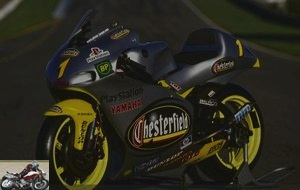 Review of Olivier Jacque’s Yamaha YZR250 OWL5
Review of Olivier Jacque’s Yamaha YZR250 OWL5
Discovery
Exactly 20 years ago, in 2000, Yamaha had a particularly exceptional racing season, a season which at the same time was to be forgotten for its rival Honda. In the five circuit racing categories contested that year, Yamaha won five of the ten possible world championship titles: the driver and constructor titles in 250 GP and Supersport 600, plus the constructor title in the GP 500 World Championship, not to mention second place in the WorldSBK driver standings after a controversial penalty imposed on Noriyuki Haga. Yamaha fought all season to reverse the trend, but it was Colin Edwards who won the crown on the Honda, the manufacturer’s only driver title that year..
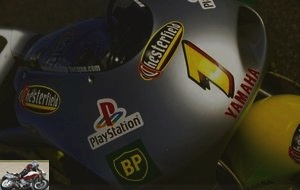 The OWL5, crowned a few weeks earlier, is now adorned with the # 1
The OWL5, crowned a few weeks earlier, is now adorned with the # 1
But Yamaha crushed the World GP 250 during this 2000 season dominated by two of its riders: the Japanese Shinya Nakano and the French Olivier Jacque who were riding the bike that was clearly the best on the grid: the YZR250 of the Tech3 team sponsored by Chesterfield..
However, the outcome of their fight against each other to be crowned world champion will remain uncertain until the last ten meters of the final round of the season’s final Grand Prix in Australia. The winner won everything: whoever wins the race also won the title. Nakano took the lead from the start at Phillip Island and was closely followed by his teammate throughout the race, leaving behind Honda rider Daijiro Katoh. The operation was risky, however, because in the event of the fall of the Yamaha duo, it would be Katoh and Honda who would win the title..
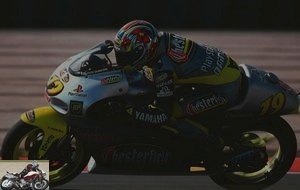 Olivier Jacque on the Yamaha during his conquest of the title
Olivier Jacque on the Yamaha during his conquest of the title
So Nakano ran this two-wheeled poker game until they both came out of the last corner leading to the Gardner straight on the last lap, with the checkered flag a few hundred yards away. Then, in a brilliantly judged gliding maneuver, Olivier Jacque passed his compatriot Yamaha to cross the finish line with only 14 thousandths in advance and snatch the world crown from him. The season was thus dominated by the duo who led the standings with eight victories in sixteen races (3 for Jacque, 5 for Nakano), eight pole positions, 23 podiums and the first two places in the World Championship. Difficult to do better, is not it ?
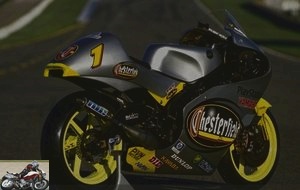 8 wins, 8 poles and 23 podiums, the YZR250 truly dominated the 2000 season
8 wins, 8 poles and 23 podiums, the YZR250 truly dominated the 2000 season
Indeed, few world titles have been won with such accuracy as that of Olivier Jacque riding the Tech3 Yamaha YZR250 OWL5. No wonder Tech 3 boss Herve Poncharal was exhausted with emotion in the press room after the race, when I congratulated him for accomplishing his mission.
“I don’t want to have to go through that again! Winning the title is great, but knowing that the slightest fall could have cost us everything got us on the edge of our nerves. I feel as much relief as elation that everything has gone well. pass."
The opportunity to ride Jacque’s Yamaha YZR250 a month later at the Jerez circuit, just weeks after testing Katoh’s third NSR250 in Japan, revealed the secrets of Yamaha’s success. First of all, while Tech 3 mechanic Josian Rustique was preparing the bike for me, I was able to feast on the countless details of what was surely the most iconic bike on the GP starting grids, all categories combined, from the 2000 season. She was also reliable, with no mechanical abandonment throughout the year. It also seemed easier to work with than the NSR250, with all parts more accessible and a much less critical engine setup. Just put on gas, inflate the tires and go! Of course, Tech 3 and OJ were in the Honda camp until the 1999 season. So they had a good basis for comparison….
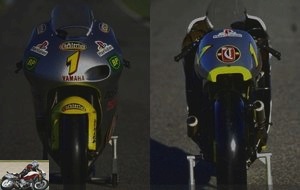 The Yamaha YZR250 OWL5
The Yamaha YZR250 OWL5
The YZR250 could have been Italian. It was so beautifully detailed and so distinctively done. It was a motorcycle that you could watch for ten minutes and find something new to admire every ten seconds. Like the two air boxes required due to the patent filed by Honda on the central monobloc format, formed by beautiful molded carbon fiber parts each incorporating an air duct with a low inlet on the right side of the fairing and the another shift to the left of the fork crown. Or the radial mounting of the Nissin four-piston front brake calipers, metallurgical works of art carved in the mass. Or the fairings on the two 273mm carbon brakes, adapted to retain heat even in hot weather such as test day. Or the large curved radiator whose volume gives an idea of the heat that must be dissipated with a power of more than 90 hp, according to Yamaha, but which reliably reaches 97 hp at 12,800 rpm, so less than the rival Honda NSR250, but comes with a more efficient package.
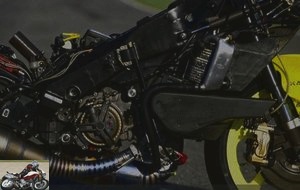 The air box has an asymmetrical design, here with the entry of the right side
The air box has an asymmetrical design, here with the entry of the right side
But there is more. Like the welded titanium exhausts, topped at one end by French MIG mufflers and at the other by Yamaha’s power-valve system. Or the German-made magnesium forged PVM wheels that saved 150 grams of unsprung weight at the front compared to the cast-alloy ones and twice as much at the rear. Or the Kayaba suspension that Tech 3 had been using since 1995, even on the factory Honda cars it raced until the previous season and which the team insist played a key role in winning the title. World of Yamaha, here with a 41mm inverted fork and "banana" swingarm. Or how Yamaha had centralized the masses of the bike so well, as can be appreciated by noting how the pivot axis of the long R1-type swingarm is located almost in the middle of the 1,330mm wheelbase, offering thus improved traction. They had also positioned the V-twin engine at 90 °, measuring 54 x 54.5 mm, far enough forward to load the front wheel, a feature particularly appreciated by OJ, whose high cornering speeds required a front tire. Dunlop harder than his teammate’s. Or … well, it’s time to stop admiring the bike and get on board to see for myself how OJ won the title. And Yamaha too, of course…
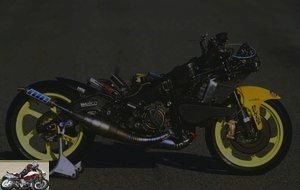 The swingarm pivot is almost in the center of the wheelbase
The swingarm pivot is almost in the center of the wheelbase
In the saddle
But we do not ultimately stop there. Because Jacque’s Yamaha OWL5 YZR250 had what was arguably the most original Grand Prix cockpit at the time, with the narrow, domed bubble perfectly designed to deflect air from the helmet, while the wide sides of the "hood" nose took care to protect your shoulders. Rather unexpectedly, despite the narrow and much lowered straps, the riding position is actually relatively roomy, even for a 6ft rider like me. I was thus able to pretend to be like OJ by molding myself on the bike along the straights of Jerez, tucked behind this enveloping fairing..
 The enveloping fairing of the YZR250 provides good protection
The enveloping fairing of the YZR250 provides good protection
OJ’s first words after first sitting on the Yamaha in 1999 were: "I feel like I’m sitting in a chair!". And indeed, it had been a long time since I had felt so comfortable aboard a GP 250. Although it looked less like a toy than the Honda NSR250, smaller and narrower and which finally had the he looks like a big 125, the physically larger Yamaha is still very agile despite its bulky fairing, which does not detract from the ease with which you can move on the bike in a curve. It turns beautifully, with very little steering damping needed to keep it straight. A good point because the shock absorber is, unlike usual, mounted on the right side, so adjustments while driving are impossible without releasing the accelerator !
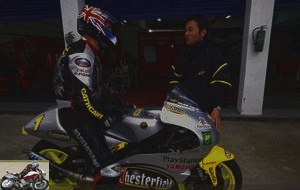 Rather large for a 250, the Yamaha is also suitable for the 1m80 rider
Rather large for a 250, the Yamaha is also suitable for the 1m80 rider
Test
The engine is slightly less explosive than the Honda 250, but it seems intentional and above all usable, although to be able to get out of a bend quickly you have to put the needle above 8,800 rpm. This is where OJ made a mark and where the power comes in full force. The engine therefore resumes lower, but not as strong as the power curve peaks between 11,000 and 13,000 rpm. A little more power at the bottom would have been nice, but working with the gear selector and its perfectly tuned powershifter allows you to take advantage of all the power offered. Although the gear change indicator lights up on the screen from 13,000 rpm, the speed can be maintained up to 13,800 rpm even if there is a very gradual drop in power. The engine even continues to pull up to 14,400 revolutions if you insist. But since the cassette gearbox is so easily removable to change the ratios, this is not really necessary a priori..
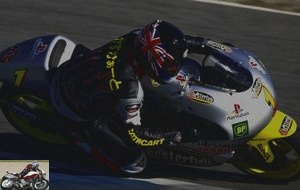 The V-Twin delivers up to 97 horsepower at 12,800 rpm
The V-Twin delivers up to 97 horsepower at 12,800 rpm
The extra laps that Ichiroh Yoda’s engineers provided for this 2000 season were a crucial part of OJ’s success, according to Josian Rustique. Because it made the Yamaha easier to ride in 250 duels, allowing gear to be held longer when needed. But by surfing lower on the torque curve, you have to be prepared for that 97 kg quarter-liter jewel to lift its front wheel when exiting the Dry Sac hairpin bends or the Curva Lorenzo which leads to the straight line of the pits. The Yamaha definitely has more power at mid-range and is therefore better suited than the Honda to get out of slow corners..
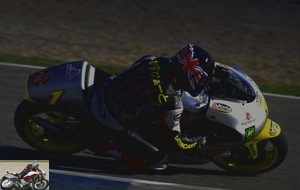 The Yamaha weighs only 97 kg without gasoline
The Yamaha weighs only 97 kg without gasoline
However, it was not as critical a point as the handling of this YZR250 that was really the key to its success. This allows you to maintain a corner speed at an improbable angle, while remaining fairly stable even when you encounter a fault on the asphalt, as in exiting the Curva Pons fast turn when the Kayaba suspension absorbs the stress. a few bumps (from the time) while we open the throttle wide while the rear is compressed and the front is lightened. This is exactly the kind of situation where Nakano complained about the lack of grip at the front of the bike in 1999. But the modifications made by Yoda helped correct the problem. At my cooler pace than OJ’s, the handling of the Yamaha is blameless. It conveys a polished and precise driving style. It is not a motorcycle that likes to be driven aggressively, but just quickly and even with a touch of delicacy. Momentum is everything on the Yamaha which rewards the wide trajectories in curves. The machine was therefore perfectly in line with the style of OJ.
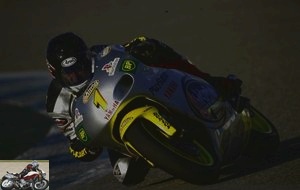 The handling is undoubtedly the strong point of the bike
The handling is undoubtedly the strong point of the bike
One odd thing that took some getting used to is the soft, almost soft brake lever that Olivier Jacque apparently insisted on. The first time I grabbed it while accelerating out of the pits, to heat the carbon discs for the first lap, I thought there must be some air in the system. Then I realized that it works pretty well because you end up with a more gradual feel and improved sensitivity compared to a harder lever where it’s all or nothing. And, it goes without saying that on such a small motorcycle that weighs only two kilograms more than the minimum weight allowed in the 250, the stopping power of the Nissin radial monobloc calipers is nothing short of impressive. Thanks to the fairings, the 273mm carbon discs retain heat well, so even at the end of the straight line, response is instantaneous when the lever is fully squeezed. When this happens, the Yamaha remains stable on big stops, despite the mass transfer caused by weight forward and lifting the rear if care is not taken to use the rear disc while it does. first place to counter this transfer. Interestingly, the exact weight distribution is the only data "unavailable" on this bike, but it was probably a key factor in making the front tire stick so well to the ground in curves, allowing braking further down the road. turn, without worrying too much about losing the front. The cycle part is beautifully balanced and neutral. So whatever "fixes" Yoda-San and his men may have made to improve handling this season, it really worked..
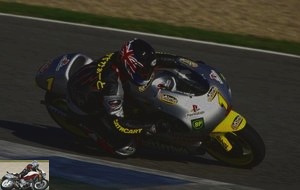 Once you get used to it, the braking is extra
Once you get used to it, the braking is extra
Conclusion
However, it was quite embarrassing to manage to complete a lap faster on the YZR250 in Jerez than on Carlos Checa’s YZR500 that I rode the same day, although I was faster on Nori Haga’s R7 Superbike. , which must mean something! But it all depends on the handling of the two motorcycles. Because during the many years that I tested the GP 5000 two-stroke factory, I readily admit that it was the bike that was in control, not me. The secret of my survival lies in the fact of having accepted that to pilot the machine as it dictated to me. On a 250, it was the opposite: I lead the dance, not the bike. But the problem is, because of my taller size more suited to Superbikes, I usually couldn’t ride them as fast as they could for the simple reason that I was too tall. Well, OJ’s 2000 World Champion Yamaha is sort of the 250 of a dream for anyone of "normal" height. The fact that I had to be forced off the bike at the end of the last day of testing in Jerez underlines how fun such an efficient package was to ride, the result of four years of work by the Yamaha engineers to reverse the odds. Respect.
 Brilliant, the YZR250 OWL5 was also the last Yamaha to compete in GP 250
Brilliant, the YZR250 OWL5 was also the last Yamaha to compete in GP 250
Unfortunately, after completing its mission in the World Championship, Yamaha officially left the 250 class at the end of 2000 to focus on the development of its new four-stroke MotoGP for 2002. This makes OJ’s world crown the last of 14 world titles that Yamaha has won in 250 since it was first clinched by Phil Read in 1964. I have been fortunate enough to ride every type of bike the Japanese firm has used to win these titles except the V4 RD05A with which Read and Bill Ivy had finished 1st and 2nd in 1968. Apart from that, Olivier Jacque’s World Champion YZR250 OWL5 was undoubtedly the best Yamaha and certainly one of the most beautiful successes of the GP 250. C is why she spent the 2000 season at the forefront, where she should be…
Strong points
- Maneuverability
- Agility
- Acceleration out of curve
Weak points
- Less powerful than the Honda
The technical sheet of the Yamaha YZR250 OWL5
Related articles
-
Yamaha YZR500 OW48R motorcycle test
Kenny Roberts’ 3rd title bike in 1980 4 cylinders in line, 2-stroke, 498 cm3, 102 hp, 135 kg This is the year of the pyramids in motorcycles, with a good…
-
Yamaha RZV 500R motorcycle test
GP 500 2 stroke … road ! 50 ° V4, 494 cc, 100 hp, 134 kg Sports bikers are familiar with the Yamaha RD 500 LC, inspired by Kenny Roberts’ YZR500….
-
Yamaha VMAX Cafe Racer motorcycle test
Rocket hyper modified by Roland Sands Design The Power Cruiser stripped down to lose 36 kg The Yamaha VMax is undoubtedly one of the most iconic…
-
Suzuki RGV500 XR89 motorcycle test
The ultimate evolution of the 500 GP 2T 2000 World Grand Prix champion with KR Jr, Kenny Roberts Junior Like father, like son Mission accomplished. After…
-
Yamaha VMax 1700 motorcycle test
The return of a legend The return of the good, the bad and the tonic-truante. Certain celestial objects cross our orbit according to a periodicity which…
-
Yamaha YZF-R7 OW-02 superbike test drive
Noriyuki Haga’s motorcycle from WSBK 2000 4 cylinders in line, 749 cm3, 172 hp, 162 kg dry The four-year racing ban imposed on Andrea Iannone, now a…
-
Track test: An R1 or Nothing ? Queen of beauty, the R1 has won over many bikers with its plastic and dynamic qualities. In 14 years of existence it has…
-
Honda CB1100R T-Rex motorcycle test
The best Post-Classic sports car ever built 4 cylinders in line, 1,156 cm3, 145 hp, 160 kg, Harris frame, 273 km / h A T-Rex is big, strong, powerful ……
-
Test Yamaha XTZ 750 Super Tenere
Twin-cylinder in-line, 749 cm3, 70 hp, 6.8 m / kg, 195 kilos dry, from € 1,000 Produced from 1989 to 1995, this big and reliable road trail smells of…
-
French watch or Gallic genius ? 128 hp Honda Moto2 engine, parallelogram suspension front axle, adjustable geometry, solid 7075 T6 aluminum chassis, 154…
Hello
indeed, the original pot is quite clunky. the akra may be fitted "original" on a motorcycle package 🙂
tom4, it makes think of the benelli tnt for the front I think
Okay, I can’t find the pot bigger than the old one.
On the other hand, I am not a fan of the all digital dashboard. I hesitated between waiting for the Z8 or going straight to speed. I don’t regret my choice.
> White: excellent choice … in R ?
The Z8 puts the package on its plastic, takes care of its geometry and gives a little more engine. It is especially the availability of this one which is better.
I hope to make a comparison Z 750 R vs Z 800 …
bouh diou it’s naughty. too much manga I think
Not bad, but the exhaust silencer is really
awful. Difficult to do worse. Otherwise, this "insectoid" side
that the Japanese strive to associate with their machines, with
this lighthouse optic "which makes the big eyes", it is
really ass-ass. Mr. Kawa: you make motorcycles, not
toys for 8 year olds!
you don’t have to be 8 years old like you to drive a Z
I had 3 Z1000 and that happiness, it is the best roadster on the market.
Chances are .
.
With the IXRACE Z7 the purring is more than correct